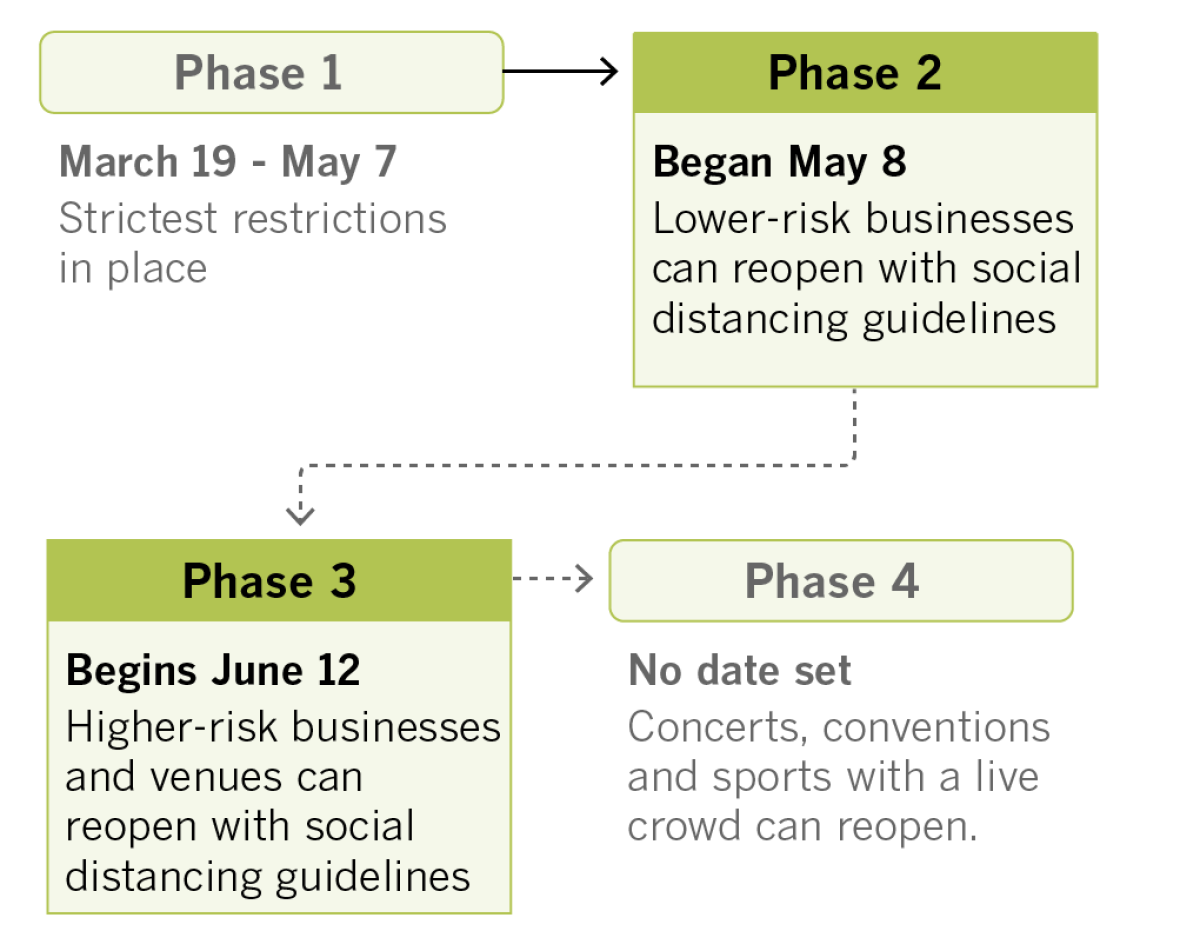Coronavirus Today: Are stimulus checks the future?
Good evening. I’m Diya Chacko, and it’s Wednesday, May 20. Here’s what’s happening with the coronavirus in California and beyond.
We’re starting to see signs of progress as California battles the coronavirus: Even as more tests are administered, the numbers of cases and hospitalizations have begun to decline, a Times analysis found.
Those two indicators have been the focus of some officials as they allow parts of the state to reopen their economies. Gov. Gavin Newsom said earlier this week that the improvement in hospitalizations was a factor in loosening requirements because it mitigated concerns that hospitals’ intensive care units could be overwhelmed by incoming patients. “Remember: The whole purpose of the stay-at home order was to prepare and to respond in the worst-case scenario,” he said.
That doesn’t mean we’re out of the woods. Other officials are still concerned about the state’s death toll, which continues to climb. California reported 132 new coronavirus-related deaths Tuesday; although that number includes results from over the weekend, it’s still the most recorded in one day since the pandemic began. Deaths in Los Angeles County alone are nearing 2,000, and local officials emphasize that being able to loosen restrictions by July 4 depends on the public practicing social distancing, covering their faces and taking other precautions.
The nationwide economic free-fall is prompting state and local governments to experiment with giving money directly to Americans, with no strings attached. Not so long ago, that kind of assistance was seen by many as likely to discourage recipients from seeking work — but the bipartisan support for coronavirus stimulus payments shows how quickly attitudes have evolved to embrace ideas along the lines of universal basic income. None of the coronavirus relief programs fully qualifies as a true universal basic income, or UBI, but they do share similarities — giving money directly to people and letting them decide how to spend it. “We’re closer than we’ve ever been,” said the mayor of Stockton, a longtime UBI proponent who last year oversaw a trial run in his city.
As infected people stream into hospitals, teams of health researchers across the country are seeking help from artificial intelligence programs. By analyzing millions of pieces of data to detect patterns that may be hard for clinicians to discern, machine-learning programs can perform tasks like deciding which patients face the greatest risk of complications and which can be safely channeled into lower-intensity care. But some experts warn that rolling out the programs in the midst of a pandemic could be confusing to doctors and dangerous for patients. “My intuition is it’s a little bit of the good, bad and ugly,” said a data science fellow at Duke University.
By the numbers
California cases and deaths as of 4 p.m. PDT Wednesday:
Track the latest numbers and how they break down in California with our graphics.

See which counties are reopening with our tracker.
Across California
Most public school districts plan to reopen campuses on their regular start dates in late August and September, state Supt. of Instruction Tony Thurmond said Wednesday. The new normal will probably mean masks, daily school sanitation and smaller class sizes to maintain six feet of distance, and some districts will likely offer a combination of in-person and distance learning. But more safety accommodations will require more money, he said, and that’s in short supply due to the $19-billion funding cut in Newsom’s revised budget. “We believe that our school districts cannot reopen safely if they have to implement these kinds of cuts,” Thurmond said.
The California Department of Corrections and Rehabilitation will begin accepting prisoners May 26 for the first time since Newsom suspended their intake in March. Although more than 3,500 people have been released from the state’s prisons to prevent the spread of the virus, those still inside continue to face outbreaks. The California Institution for Men in Chino, where nearly 600 inmates have tested positive, reported its sixth death Monday.
Tulare County officials have voted to reopen more businesses before meeting the health criteria set by the state. It’s one of several rural counties that have defied Newsom’s orders designed to prevent new outbreaks, although Tulare differs in that it has one of the highest COVID-19 death rates in California. If the county “believes there is no emergency” and reopens ahead of schedule, that could jeopardize its disaster funding, said the director of the California Office of Emergency Services.
Ahead of the Memorial Day weekend, some Southern California marinas have opened with new COVID-19 rules, such as asking boaters to wear face coverings while on ramps and docks when others are present. Whale-watching excursions and most ferry services remain closed, though some hope the state will give them the green light later this week.
Resources
— For general safety, wash your hands for at least 20 seconds (here’s a super-fun how-to video). Stop touching your face, and keep your phone clean. Practice social distancing, maintaining a six-foot radius of personal space in public. And wear a mask if you leave home. Here’s how to do it right.
— Watch for symptoms including fever, cough, shortness of breath, chills, repeated shaking with chills, muscle pain, headache, sore throat and loss of taste or smell. If you’re worried you might be infected, call your doctor or urgent care clinic before going.
— Here’s how to care for someone with COVID-19, from monitoring their symptoms to preventing the virus’ spread.
— If your job has been affected by the coronavirus pandemic, here’s how to file for unemployment.
— Here are some free resources for restaurant workers and entertainment industry professionals having trouble making ends meet.
— Advice for helping kids navigate pandemic life includes being honest about uncertainties, acknowledging their feelings and sticking to a routine. Here’s guidance from the Centers for Disease Control and Prevention.
— In need of mental health services? Here are resources for coping during the crisis from the CDC and the L.A. County Department of Public Health. L.A. County residents can also call (800) 854-7771 or text “LA” to 741741.
Around the nation and the world
While the six largest airlines in the U.S. are requiring passengers to wear masks or some other suitable nose-and-mouth covering during all flights, those rules are being flouted, according to complaints on social media. Instead of threatening fines or diverting flights, airline personnel are using diplomacy and de-escalation tactics to try to get passengers to comply. “Absent a federal requirement that passengers wear face coverings, airlines can do only so much,” an aviation analyst said.
Las Vegas is beginning to reopen. Restaurants are now welcoming diners, and the Caesars Palace hotel-casino is expected to reopen next month, with new rules for masks and social distancing. The number of seats at blackjack tables has been cut from six to three; craps tables will seat only six players, down from 15. As for slots, “every other game is going to be deactivated and every other chair is going to be removed,” the general manager says.
In an era of global expansion and easy travel, China was financing nearly half a trillion dollars in new infrastructure projects across Asia, Africa, Europe and Latin America. Although Chinese state media insist the Belt and Road Initiative remains on track, its future is now uncertain, with engineers grounded, construction sites silent and calls mounting to reschedule loans for shipping facilities, electrical plants and transport links. The east African nation Djibouti’s total debt to China exceeds 80% of its GDP. “To be honest, no one at this stage can afford paying anything due to the crisis,” its finance minister says.
Your questions answered
Today’s question comes from readers who want to know: Is it safe to swim? Reporter Christopher Reynolds looked into it.
Good news: Experts say it’s unlikely that someone could become infected with the coronavirus by swimming in a pool or in the ocean. Research so far shows that the virus’s principal means of transmission is respiratory.
“I can’t say it’s absolutely 100% zero risk, but I can tell you that it would never cross my mind to get COVID-19 from a swimming pool or the ocean,” said a professor at USC’s Keck School of Medicine. “It’s just extraordinarily unlikely that this would happen.”
The chlorine in most swimming pools is enough to inactivate the virus. And there is no data suggesting that it is viable in ocean saltwater, scientists say.
If you do make a visit to the pool or beach, the best way to protect yourself is to keep your distance from others. Swimmers should stay well separated and take care to avoid surfaces other people may touch, like lockers in changing rooms, or public benches and tables.
And officials still require face masks at most of California’s beaches, so be sure to bring yours with you.
Got a question? Our reporters covering the coronavirus outbreak want to hear from you. Email us your questions, and we’ll do our best to answer them. You can find more answers in our Frequently Asked Questions roundup and in our morning briefing.
For the most up-to-date coronavirus coverage from The Times, visit our homepage and our Health section, listen to our “Coronavirus in California” podcast and follow us on Twitter and on Instagram.





